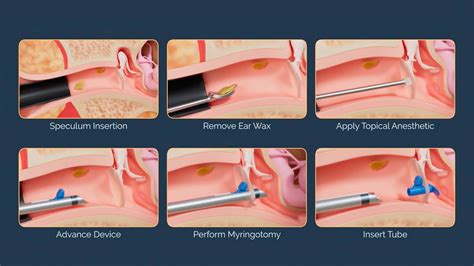Intro
Learn about ear tube insertion, a common procedure for treating ear infections, featuring tympanostomy tube placement, middle ear ventilation, and hearing loss prevention, explained in detail.
The ear tube insertion procedure is a common surgical operation performed to treat recurring ear infections, also known as otitis media, and to alleviate hearing problems caused by excessive fluid buildup in the middle ear. This procedure is particularly prevalent among young children, as their Eustachian tubes are still developing and are more prone to blockages. However, adults can also undergo ear tube insertion if they experience chronic ear infections or persistent ear discomfort. Understanding the ear tube insertion procedure is essential for individuals who are considering this treatment option or want to learn more about it.
The importance of addressing ear infections and fluid buildup in the middle ear cannot be overstated. If left untreated, these conditions can lead to complications such as hearing loss, speech development delays in children, and increased risk of future ear infections. The ear tube insertion procedure offers a relatively simple and effective solution to these problems. By inserting small tubes into the eardrum, doctors can help to ventilate the middle ear, reduce fluid accumulation, and prevent future infections.
The decision to undergo ear tube insertion is typically made after consulting with an ear, nose, and throat (ENT) specialist or a pediatrician. These medical professionals will assess the individual's condition, discuss the potential benefits and risks of the procedure, and determine if ear tube insertion is the most suitable treatment option. It is crucial for patients and their families to be well-informed about the procedure, including its preparation, execution, and post-operative care. This knowledge will help to alleviate concerns, ensure a smooth recovery, and maximize the effectiveness of the treatment.
What is Ear Tube Insertion?

Benefits of Ear Tube Insertion
The benefits of ear tube insertion are numerous and well-documented. Some of the most significant advantages include: * Reduced risk of future ear infections * Improved hearing and speech development in children * Decreased discomfort and pain associated with ear infections * Faster recovery from ear infections * Reduced need for antibiotics and other medicationsPreparation for Ear Tube Insertion

What to Expect During the Procedure
During the ear tube insertion procedure, the patient will be placed under general anesthesia to ensure comfort and relaxation. The ENT specialist or surgeon will then: * Make a small incision in the eardrum * Remove any fluid or debris from the middle ear * Insert the tympanostomy tube into the eardrum * Verify the tube's position and functionalityPost-Operative Care and Recovery

Potential Risks and Complications
As with any surgical procedure, ear tube insertion carries potential risks and complications. These may include: * Infection or inflammation of the ear * Scarring or perforation of the eardrum * Displacement or blockage of the tympanostomy tube * Hearing loss or tinnitus (ringing in the ear)Long-Term Outcomes and Follow-Up

Tympanostomy Tube Removal
Tympanostomy tubes are typically designed to fall out on their own within 6-12 months after insertion. However, in some cases, the tubes may need to be removed surgically. This procedure is usually performed under general anesthesia and involves: * Making a small incision in the eardrum * Removing the tympanostomy tube * Verifying the eardrum's integrity and healing progressConclusion and Final Thoughts

What is the purpose of ear tube insertion?
+Ear tube insertion is performed to treat recurring ear infections, alleviate hearing problems caused by excessive fluid buildup in the middle ear, and improve ventilation of the middle ear.
How long does the ear tube insertion procedure take?
+The ear tube insertion procedure typically takes around 15-30 minutes to complete, depending on the individual's condition and the surgeon's expertise.
What are the potential risks and complications of ear tube insertion?
+Potential risks and complications of ear tube insertion include infection or inflammation of the ear, scarring or perforation of the eardrum, displacement or blockage of the tympanostomy tube, and hearing loss or tinnitus.
We hope this article has provided you with a comprehensive understanding of the ear tube insertion procedure, its benefits, and its potential risks. If you have any further questions or concerns, please do not hesitate to comment below or share this article with others who may find it helpful. Remember to consult with a qualified medical professional before making any decisions about your treatment options.
